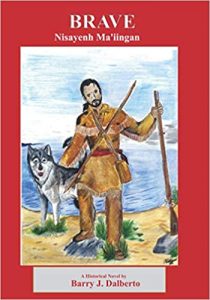Review by Donna Winters
 Detail. This is the overriding characteristic of Brave —Nisayenh Ma’iingan, Barry J. Dalberto’s historical novel about Lake Superior and fur trading in the early nineteenth century. He’s great about detailing settings, and sometimes his detail is in the form of a list. Other times, it comes out as a character’s mini-bio. All of this convinces the reader that Dalberto has done a massive amount of research and crammed it all into this novel. As a result, the preponderance of details sometimes overwhelms the story. But stick with it. You can always speed-read through the too-detailed passages that frequently repeat an earlier description.
Detail. This is the overriding characteristic of Brave —Nisayenh Ma’iingan, Barry J. Dalberto’s historical novel about Lake Superior and fur trading in the early nineteenth century. He’s great about detailing settings, and sometimes his detail is in the form of a list. Other times, it comes out as a character’s mini-bio. All of this convinces the reader that Dalberto has done a massive amount of research and crammed it all into this novel. As a result, the preponderance of details sometimes overwhelms the story. But stick with it. You can always speed-read through the too-detailed passages that frequently repeat an earlier description.
The story opens in July 1801 at Grand Portage Fort on the northern shore of Lake Superior. The main character, Marq (Marquez Fisher), in his mid-twenties, goes fishing for lake trout that will feed the fort’s personnel. This is the first of many fishing trips the reader will vicariously experience with this son of a white father and Ojibwe mother. Both parents have already passed away, but Marq’s younger sister, Fawn, continues to live with their Ojibwa community on an island in Lake Superior. She enters the story in the final chapters.
Marq’s boss is Sean McTavish, head clerk at the fort. Sean, of Scottish Highlander ancestry, has hired Marq to supply fish and game for the fort. We quickly learn that their relationship is much more than that of boss and contractor. They are the best of friends, constantly watching out for one another.
Early in the story, Marq adopts a husky-wolf pup whom he names Brave. The dog becomes a larger-than-life character, never misbehaving, learning quickly, and saving Marq, Sean, and others on several occasions. Brave even warns of a dangerous fog closing in on the voyageurs’ canoe that will put them in peril if they don’t head for shore. Clearly this author loves canines and draws the tight relationship between Marq and Brave with great care and sensitivity. And with many repetitious details.
Foodies will love this novel. Among the plethora of details are several describing the meals and exactly how they are prepared. From fish, to caribou, to fry bread, to stews, it’s all there to savor in Dalberto’s fictional world.
After a big meal, one will naturally desire to visit the outhouse. This, too, does not escape description in the story. “There were board partitions between the stalls with a single hole cut into the seat and swamp moss for wiping.” Didn’t we all want to know how mankind coped prior to the printing of the Sears catalog or the invention of toilet paper rolls?
A good example of the author’s expertise with lists is this one that appears on page 17 and describes items brought from Montreal that couldn’t be grown or found at the fort.
…salt, dried corn, beans, black peppercorns, wheat flour, brown sugar, spices, tea, and nuts.
…axes, saws, broad cloth, shovels, hoes, shiny metal pendants, cloth leggings, capotes, wool blankets, knives, glass beads, flintlock rifles, awls, black powder, gunflints, tobacco, vermillion, lead balls and fine lead shot, sword blades, metal kettles, fish hooks, blue serge caps, shirts of Brittany linen, wool stockings, net thread, sewing needles, Venice beads, iron arrow heads, soap, sabers, cutlasses, rum and high wine or Canadian brandy.
As for character descriptions, the author sometimes leaves this to the characters, themselves, who wax at length about their personal history. One such incident occurs on page 71 and doesn’t end until midway down page 74 when another character interrupts the endless mini-biography with an urgent matter that must be attended to. Perhaps even the author recognized that this is a bit of an overkill where character backstory is concerned.
The pacing in this story lags during the first half but picks up considerably during the second half when Marq begins a guide job taking North West Company men around Lake Superior on a survey tour. Many dangers lurk, with action scenes spicing up the routine of paddling, singing, making camp, and eating. And Brave shines time and again as hero/savior.
Dalberto’s writing has a simplicity in style appropriate for a young reader’s novel. The folk-style cover art was evidently created by a young person referenced in the Acknowledgments. Regardless, for anyone, young or old, who enjoys early nineteenth century Lake Superior history, Brave will entertain you and teach you much.
Brave —Nisayenh Ma’iingan (My older brother, the wolf)
By Barry J. Dalberto
ISBN-13: 979-8595180320
256 pp.



